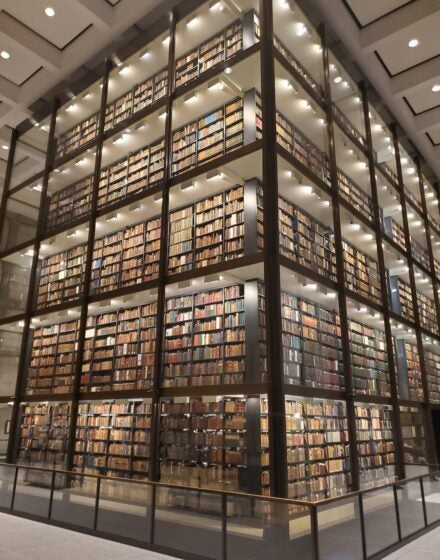The Historical & Special Collections Department (HSC) at Harvard Law School Library (HLSL) holds a world-class and historically significant rare books and early manuscripts collection. As the new manager of HSC, I recently had the opportunity to attend Law Books: History & Connoisseurship at Rare Book School (RBS), a course taught by Mike Widener and Kathryn James, the former and current Rare Books Librarians at Yale Law School, respectively. It was an amazing opportunity and immersive experience into the collecting and minutia of historical law books, learning from experts in the field.
RBS “is an independent, non-profit, and tax-exempt institute supporting the study of the history of books and printing and related subjects.”[1] Established in 1983, the program offers approximately 40 five-day courses throughout the year. The University of Virginia is home base for RBS, and although the majority of the courses take place in Charlottesville, some take place in other cities along the east coast of the United States.
Yale University has an exquisitely beautiful campus in downtown New Haven, Conn. Neo-gothic architecture permeates the area alongside other explicitly modern buildings. For example, the Lillian Goldman Law Library and Beinecke Rare Book and Manuscript Library – the latter of which where I may or may not have shamelessly introduced myself to Pulitzer Prize-winning historian David Blight while on his way to lunch – are a stone’s throw from one another. However, they could not be more dissimilar in design, both inside and out. They are both magnificent and well worth a visit.

“The instructors encouraged us to appreciate and discuss not just the intellectual merits of the works, but also the importance of each item as a physical object…from the Corpus Juris Civilis to books of statues, law-related comic books, and ephemera.”
Christopher Spraker regarding Rare Book School

As for the RBS course itself, it was a five-day deep dive into rare law books, with a particular focus on Anglo-American, European, and Latin American law. The items themselves were undeniably the best part, and students spent the majority of class time working hands-on with the material. The instructors encouraged us to appreciate and discuss not just the intellectual merits of the works, but also the importance of each item as a physical object, whether it was manuscripts, incunabula, or other rare books from the 16th through 20th centuries from the Corpus Juris Civilis to books of statues, law-related comic books, and ephemera.
We also considered: What can the shape and size of a book tell us about its original intended use? What historical tidbits might the specific materials used in the bindings and leaves, the fore edges, and so forth offer regarding the time and place in which a book was created and perhaps its second life as a collector’s item?
The class gave me a mountain of new information (including a rather large advance reading list) to consider as I work with my colleagues in HSC and HLSL to continue to develop, preserve, and provide access to our rare books and early manuscripts collection. On this note, HLSL continues to digitize many of these materials to provide free access, for anyone with an internet connection, via HOLLIS, the Harvard Library’s online catalog. These materials are at HLSL for their historical significance, to be preserved for posterity, and most importantly, to be used. I highly encourage anyone interested in any of the HSC collections to email us at specialc@law.harvard.edu.
And one last thing…If you end up in New Haven, make sure to try the pizza. If you do, and you should, go to Sally’s Apizza on Wooster Street – it’s worth it!
[1] “About RBS.” Rare Book School, 29 Aug. 2023, rarebookschool.org/about-rbs/
Contact Us
phone: 617-495-3455
email: asklib@law.harvard.edu
library website: hls.harvard.edu/library
Stay Connected
Library Innovation Lab (LIL) Blog
Instagram @hlslibrary
Facebook @hlslibrary
Et Seq blog (archived)
